This book tells the story of transport in and around London from Roman times, how an increasing number of bridges crossed the Thames, and vehicles developed from horse-drawn wagons to the evolution of railways and motor cars.
Published in July 2022 by Pen and Sword and written by Anthony Burton, this hardcover book measures around 16.5 cm x 23.4 cm, has 184 pages, and 70 colour and 70 black-and-white illustrations.
It has a published price of £25, but at the time of writing, it can be purchased online for £18.75 from Pen and Sword and for £21.89 from Amazon.
With ten chapters, the book provides a chronological look at the development of London’s transport.
Chapter One, The Beginnings, goes back to when Londinium was the capital of Roman Britain, while Chapter Two, Roads, Carriages and Omnibuses, describes the evolution of transport through to the Hansom cabs of Victorian times.
Crossing the Thames in Chapter Three explores some of the technical problems that designers faced when designing bridges to cross London’s river.
Chapter Four, The Railway Age, describes how rail travel evolved, from the Surrey Iron Railway, cable haulage on the London & Blackwall Extension Railway, and a variation of Brunel’s atmospheric railway with the London & Croydon atmospheric railway.
In Chapter Five, Train Travel in the Steam Age, the book focuses more on travel outside London rather than in the city itself, while Chapter Six, The Underground, lacks much information about the development of the network as it exists today, including its extension to include London Overground and the Docklands Light Railway.
Chapter Seven, Trams and Trolleys, covers the period from early horse-drawn trams through to the modern Tramlink at Croydon but has very little detail about the introduction and demise of London’s trams or its trolleybuses, or even an explanation of how trolleybuses differed from trams.
Motor Vehicles in Chapter Eight is more a description of the development of cars through the ages with only a brief description of London’s famous Routemaster and “bendy“ buses and trials with a hydrogen-powered bus.
Aviation in Chapter Nine looks at the development of aviation from the earliest hot air balloons through to the jet age, but has very little detail about the growth of London’s airports and their contribution to the city’s transport, with no mention of London City Airport, Luton or Stansted, which have all become established as London airports.
Recent Developments in Chapter Ten seems to be a misnomer, as although the book was published as recently as 2022, it includes details of the Docklands Light Railway which opened in 1987 and should have been included in Chapter Six The Underground, as did London City Airport which should be in Chapter Nine Aviation, and Eurostar which can hardly be termed a recent development as it was introduced after the Channel Tunnel opened in 1994.
The illustrations below are typical of what would have been London’s transport in the 18th century.
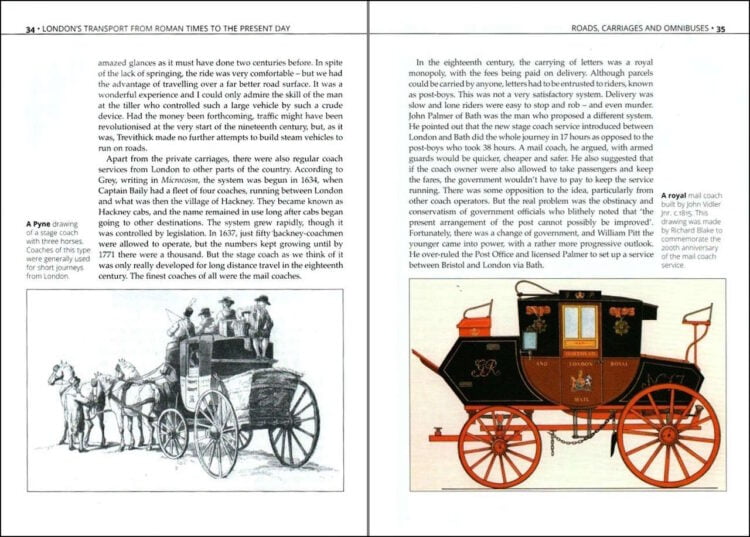
There are many bridges across the River Thames, but probably none as famous as London Bridge itself, from the children’s Nursery Rhyme London Bridge is falling down.
Tower Bridge is probably the more photographed, and it has been suggested that when London Bridge was put up for sale in 1968 before being rebuilt, its American purchaser thought he was purchasing Tower Bridge instead of the less photogenic London Bridge.
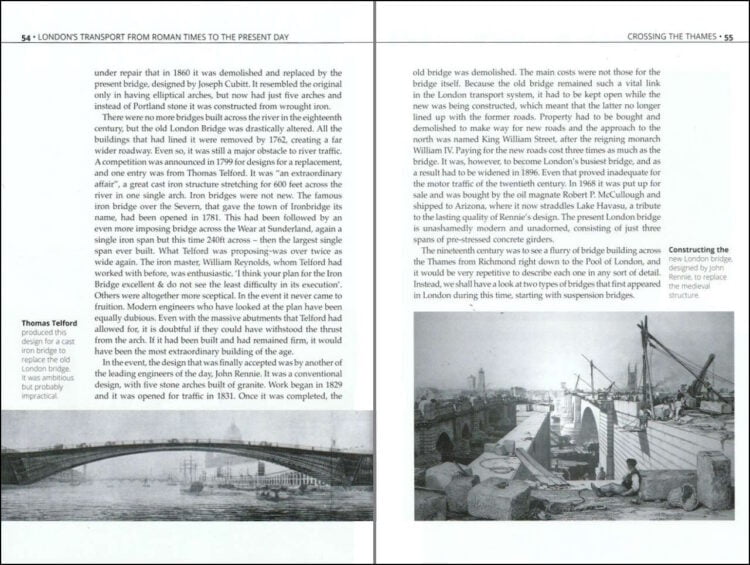
A comparison with the present-day construction of HS2 can be made in the photograph on the left below. Much of HS2 has been designed to run underground to minimise affecting the environment, but there were no such considerations during the construction of the London & Birmingham Railway into Euston.
The station itself is seen on the right.
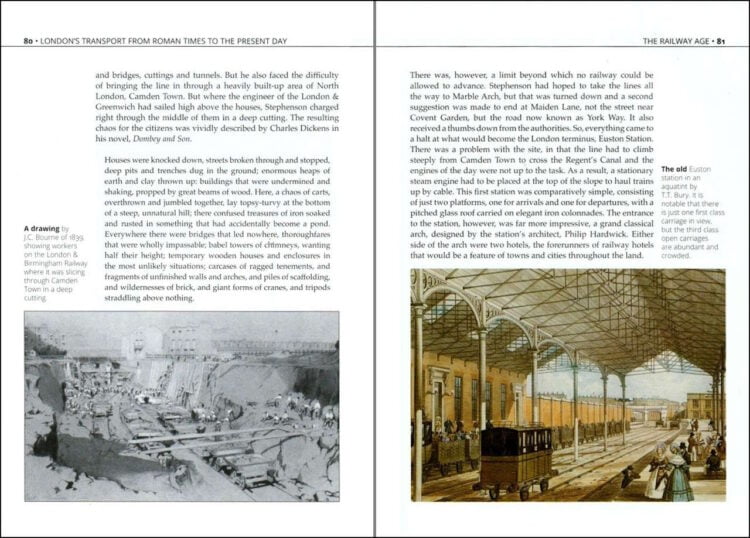
In The Underground chapter, mention is made of Harry Beck’s familiar map which superseded the geographic map as seen on the left below.
However, it would have been useful to have also included an illustration showing the present-day map as a comparison, especially as seen on the right-hand page there is ample space to have included it.
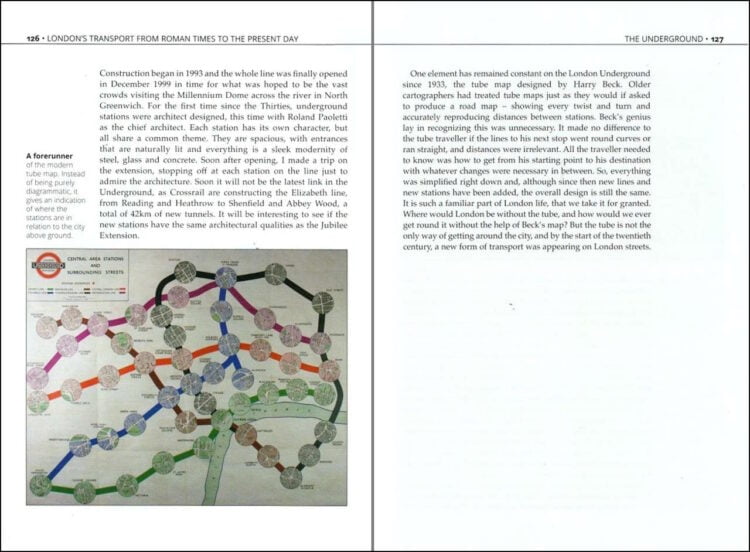
The Aviation chapter seems to be stuck in the 1950s, with a great focus on the first jet-powered airliner, the De Havilland Comet.
There is no mention of the transformation brought about by first the Boeing 707, then the 747, or supersonic travel thanks to Concord.
Similarly, there is no mention of London City Airport or the great expansion of Heathrow to five terminals.
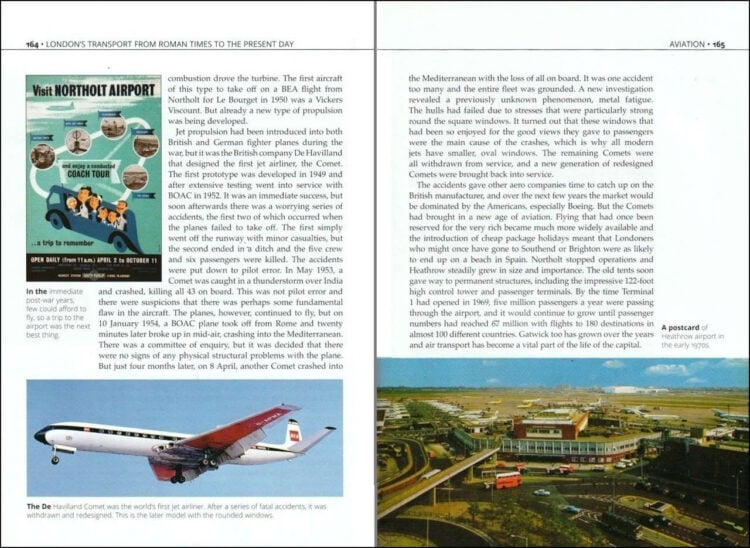
This book presents the casual reader with the background to how transport in London developed from Roman times.
Although it mentions Thames crossings, railways, road transport and aviation, it only provides a high-level look at each topic without going into technical details. Information about the Docklands Light Railway and Croydon Tramlink are included, but they are in the chapter titled Recent Development, which is rather a misnomer since they have been in service for nearly forty years.
Without going into technical details, the book examines how people moved around in Roman times with their roads and advanced engineering to modern transportation developments, and how transport both catered for and contributed to the growth of the city.
Each chapter seems to cover the various modes of transport, but the descriptions are often cursory and lacking very little detail and few details about how competing companies battled for custom. In the Trams and Trolleys chapter, there is no explanation of how trolleybuses differed from trams, even though most people born after 1960 will have no concept of what they were.
A great omission is that except for the River Thames, there is no mention of water transport, as waterways such as the Grand Union Canal and the River Lea Navigation were a reliable method of transporting goods to the capital long before the introduction of railways.
To try to cover 2,000 years of history in a book of this size was always going to be a challenge. In doing so, it only provides brief details of each mode of transport.
The book is available to purchase from Amazon and from Pen and Sword.
We would like to thank Pen and Sword for providing us with a copy of the book for review.






Responses